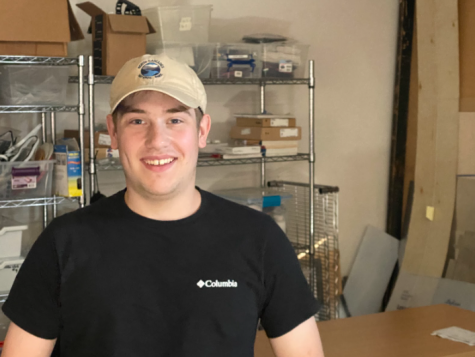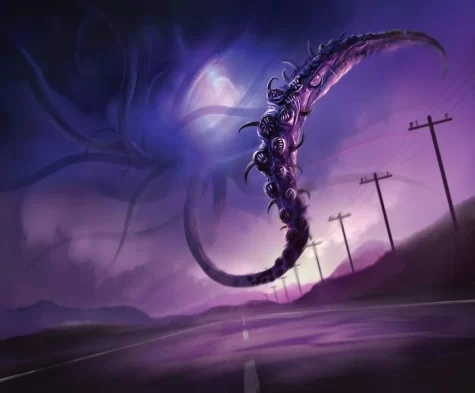The Unappreciated Faces Behind Your Favorite Shows
Why Television is Bigger Then You Think
Fiction is one of the best human inventions. Whether film, literature, or game, most humans have some form of strong attachment to narratives and the world that can be made from simple ideas. The elements of what makes a truly good story are very abstract and difficult to pinpoint, consisting mainly of small untrackable details across multiple different fields and creators.
When it comes to visual fiction in particular, especially episodic television, writing is considered the only tool in which a story can be told. As I see it, many see lighting, camera work, costume, music, and all that not seen on screen as a required element, something to show a story, not to assist it in its impact and quality.
In my opinion, the public view of the less seen aspects of the creation of television is unacceptable. Ideologies like this lead to more dull, uninspired attempts at the 10 episode streaming original format, too boring to even look at, much less watch. To understand what the quality of all these elements does is to understand what makes a quality show.
Television has always needed a village in order to run smoothly. The final episode of my favorite show alone had a total crew of 158 credited people. As much praise an actor, show runner or even director gets, no show can run without its smaller elements.
It is said a cinematographer is doing their job if you forget they exist, and while I find this statement flawed, I believe that, in concept, the same is true for nearly every individual on a set. From the arts departments, dealing with set dressing, props, graphics and construction, to the editorial department, which deal in colorism, post production, and online editing, to camera and electrical department, containing the electricians, operators, and loaders, even the transportation departments, housing the camera car drivers, as well as any cars used, any transportation of set, prop, or cast, and any trailers for quick makeup or cast and crew breaks. All this is to say, a show is nothing if reduced to one key element as its focus. When it comes to focusing on just writing or just visuals, a showrunner may as well be focusing on just sets or just cinematography.
A quality TV show, due to its far more longform nature giving it plenty of room to breathe, has not only the ability, but responsibility to use all the tools at its disposal in a way that not only tells a story, but pushes it to be truly great. Any single detail in a show could be used in the way spoken words could, and for the most part, these are often far more powerful.
One show that shows an amazing awareness of the importance of all the tools at its disposal is Sam Esmail’s techno-thriller ‘Mr. Robot’. I think the best episode to introduce how exactly this is done is the show’s penultimate episode, ‘whoami’ and the scenes of Elliot’s introduction to the final arc of the show.
Following the opening monologue, we are shown a rotating pedestal shot of our main character, laying in the middle of a completely empty lot, causing a sense of complete cosmic dissonance and sense of slight dizziness as we attempt to understand the situation. Following the scene and an extreme long shot to confirm the strangeness, a familiar song kicks in as we follow Elliot’s confusion. The scene, by using Styx’s hit 80s song ‘Mr. Roboto’, creates not only a sense of freshness to our new environment, but finality in its almost obvious use in its near namesake as the intro to its goodbye. While lyrically, the song has some interesting parallels to the circumstances of our main character, the feeling of it all coming full circle makes the entire episode that much more impactful as a result. A simple song that wouldn’t usually create this feeling almost forces it due to an element of the show as simple as its title as we once again see Elliot in his hometown, title card fading in with the lyrics. The unnatural happiness and the confusion are both synced to the cheery tone Mr. Roboto carries. We continue on with this genius accompaniment as we pan over the town, using colors unusual to the show’s usual drabness to make the viewer that much more aware of the unusual feeling the town now holds. This use of pre-existing association, cinematography, and color shows exactly the importance of the techniques, without them, the scene lacks the confusion and finality that it necessitates.
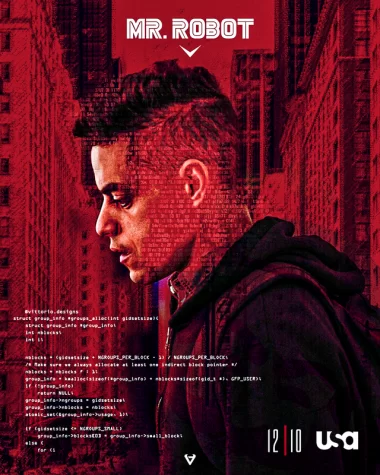
I would also like to point out this show’s ability to use resources to help its story that are usually neglected by even fellow show runners like Esmail. Specifically in the descriptions and titles of the episodes and songs. Mr. Robot uses a tactic known as idiosyncratic episode naming, that is: using a convention when naming episodes, but it also seems to use this for music and descriptions, which is very uncommon, especially in a non-comedic environment. One example of this is season 3’s 3rd episode, entitled ‘eps3.2_legacy.so’, which has its description as “hi. im tyrell wellick, former interim CTO of E Corp. ive been gone for a while. its time for an AMA!” Each title of a Mr. Robot episode is styled as a file, with type varying from season to season (with an exception to season 4, of which, each episode is titled like a HTTP client error 4XX code for the first 10 episodes, such as a ‘404 not found’ code). As for the descriptions, we see them styled, for the most part, like various types of forum post, including ill-used acronyms and abbreviations, a lack of capitalization for the most part (outside of acronyms and exception names like E Corp), and a general lack of seriousness (outside of where it is completely inappropriate, these are also sometimes used to make jokes for the viewer after they watch the episode). Using these aspects of a show so forgotten that they are seen used mainly as advertisements for an episode to build motif before the watcher even presses play is not only an amazing use of the tools the show was given, but a way that completely rethinks something simple into something game changing for the way one can bring a viewer into a world without a second of video wasted doing so.

Another great example of this, as well as another work Esmail had a hand in, was the Prime Video original ‘Homecoming’ by Eli Horowitz and Micah Bloomberg. I particularly want to highlight season 2 episode 6 ‘Needle’ and its final few minutes. For some vague, spoiler free context, this episode marks the end of the pre-memory loss section of the second season. It immediately follows the explanation of the main character’s chemically induced amnesia, and leads right into the first episode timeline wise.
The main star of this example is the music, as composed by Emile Mosseri. The song itself, Calico’s Needle, combine’s the piano intensive melody of the main character’s theme, along with her girlfriend (and fellow lead)’s violin intensive music. After an almost shocking sounding beginning, the song starts initially with a typical calm reprise of Calico, adding more flowy, almost dream-like scales as we see the effects of the memory loss kick in. Due to the accompanying cello in the background, the song grows to an intensity that still brings me chills after hearing it so many times. Due to association (even matching along dynamically to the visuals, cutting to Temple as the violins kick in) these two are both brought directly to the forefront of anyonewatching’s mind, implications being laid aside. Through
the use of building strength of the piano, violin, and even quite choir that builds the intensity further, using only our main character’s final call to Temple as dialogue, as well as the reprise of the song we hear in episode one, the show causes a feeling of unavoidable tragedy and consequence to come, without much in the way of acting or dialogue to create it. The strength of a powerful song is as great, if not greater than the words and visuals it accompanies. This scene doesn’t just use the music to assist it, it completely depends on it, not just to fill up audio where there’s no dialogue, but to make you feel complete and utter dread as the song looks you in the face and tells us that the only good thing these characters have, their relationship, has fallen victim to these circumstances, their actions are already irreversible. Without the music, this dread isn’t just dulled, it’s completely eliminated, there’s no sense of looming regret, no sense of fear of what’s to come, just the knowledge of the next few events in the timeline. Music, when used right, is a tool so powerful, it can completely create emotions not present in the original scene, which cannot be said for most other aspects of a show.
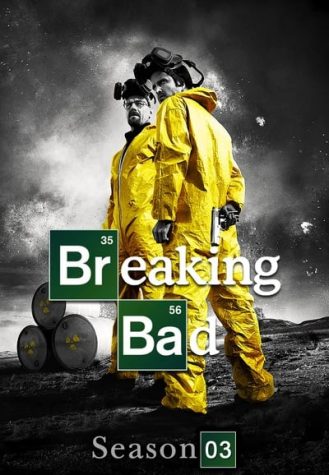
One final program I feel shows another variation of this is the far more renowned show: Vince Gilligan’s Breaking Bad. Less one specific episode, but rather overarching themes in costume and design through the whole of the show.
Where I feel this show really proves the ability of wardrobe and symbol is throughout season 3 with the blue and orange ribbons that are worn by most Albuquerque residents throughout the season on their lapels. This ribbon is of significance as, for a multitude of different reasons, it is worn in memoriam of a devastating plane accident caused by the main character’s
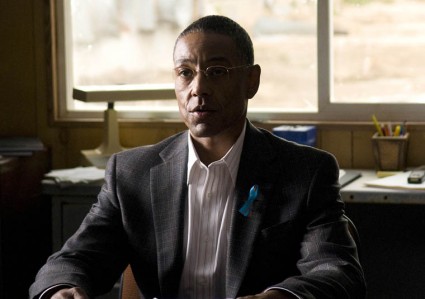
continuous chain of immoral choices the season prior. Throughout the season, though the crash would otherwise be forgotten by the viewer in all the other drama or downtime given, there is always that looming reminder of our main character, of the facade he has up around his friends and family. While the colors of outfits being used to represent mental and moral state elevates the show as well, I feel as though this example of symbol to elevate story is far deeper than what any dialogue could have achieved. The visual reminder of this action forces the viewer to always keep that action in mind, which allows for its effect to feel more devastating, even if the crash itself never killed or harmed any on screen characters in the process.
Television is absolutely my favorite medium of visual storytelling, I think many agree. The medium has so much power in how it tells its story. This is all because of people like Mr. Robot’s Kostas Theodosiou (colorist), Todd Campbell (director of photography), and Dan Kremer (sound designer) or Homecoming’s Emile Mosseri (composer), Catherine Joy (score producer) and the entire orchestral team or even Breaking Bad’s Kathleen Detoro (costume design), Wynema Chavez (costumer), and Steffany Bernstein Pratt (costume supervisor).
No show can attribute its competence to one single person, one single department. When you watch a show, you are watching the product of months worth of effort done by hundreds of people. To lose any small detail is to ruin the product. And that? That’s the beauty of television.

